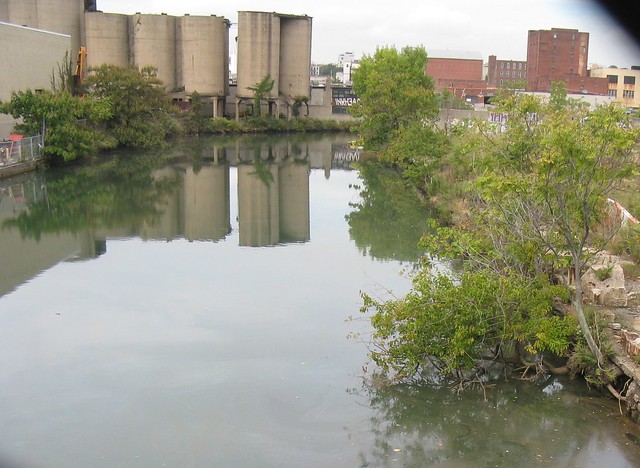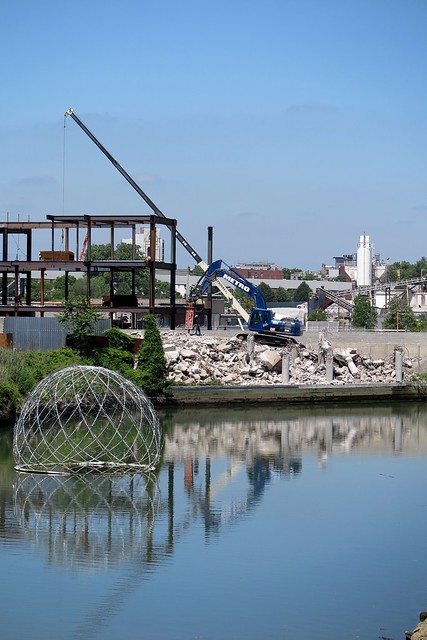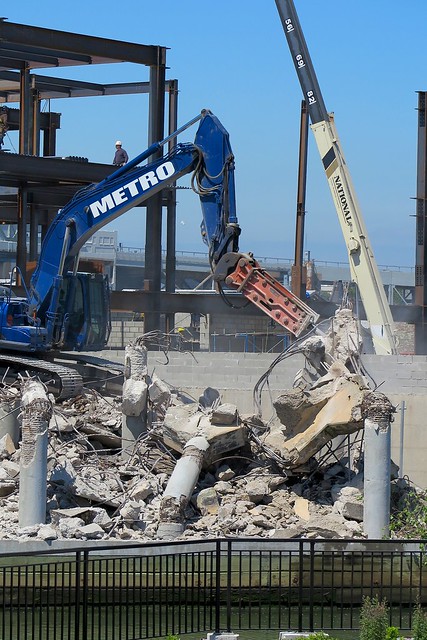The National Register is the "official list of historic properties that have been recognized as significant in American history, architecture, archaeology, engineering, or culture."
The vote by SHPO was the culmination of ten years of dedicated work and historical research, and was a recognition of Gowanus' rich and diverse heritage.
Friends and Residents Of Greater Gowanus (FROGG), a local non-for profit community group, was instrumental in helping to highlight the urban industrial character of the Gowanus Canal Corridor and had worked closely with SHPO, The Historical District Council, and the Preservation League of New York State to get to this point.
SHPO was expected to approve the listing.
However, instead of voting, the agency granted New York City a 60 day postponement to study the proposal and prepare comments.
Shortly afterwards, on May 12, SHPO notified FROGG they would not pursue listing the district at this time.
Obviously, SHPO's announcement disappointed many in the community. FROGG has just released a statement regarding the postponement of the Review of the Gowanus Historic District Listing on the State Register of Historic Places.
Below are FROGG's comments on the announcement:
In 2004, a United States Army Corp of Engineers Resources Assessment found the Gowanus Canal eligible for listing on the National Register of Historic Places. In 2008, FROGG began the process of formally nominating the Gowanus Canal District to the State and National Registers of Historic Places. FROGG received funding from five major grantors (the most important grants were from the National Trust for Historic Preservation and the Preservation League of New York State) and from donations from Gowanus business owners and community members. These funds and donations totaled more than 50,000 dollars, which were used to pay for a Comprehensive Architectural Survey of the Gowanus Canal Corridor. This Survey was required by SHPO for the nomination to the State Register, and was prepared by the certified architectural historian, Gregory Dietrich. SHPO reviewed the Survey and subsequently established the boundaries for the proposed historic district. The Gowanus and adjacent communities were continually informed on the progress of the nomination through FROGG meetings and activities, and at the meetings of the Gowanus Superfund Community Advisory Group (CAG), which comprise more than 60 members and various community organizations.
In January 2014, the nomination process required that all property owners within the proposed Historic District be notified through individual letters. The property owners, and members of the community, were invited by SHPO, to attend an information meeting hosted by FROGG and SHPO representatives. The purpose of this meeting was to inform the property owners and the community about the significance of the proposed Historic District. The meeting included a question and answer session hosted by the SHPO representative Daniel McEneny. Members of Community Board 6 were in attendance. Also in attendance were guest speakers, Simeon Bankoff, the Executive Director of Historic Districts Council, Gregory Dietrich, and Erin Tobin, representing the Preservation League of New York State. Information handouts were made available to all meeting attendees.
The meeting kicked off a 30 day period for owners to consider the listing and submit objection letters to the State. The invitation letters and the information presented by Daniel McEneny clearly informed the owners/attendees that the State would not go forward with the listing, should over 50% of the property owners choose to opt-out of listing their properties. Daniel McEneny stated SHPO supported the listing, based on the historic merits of the proposed district.
FROGG Comments:
There has been much misunderstanding and misinformation about the Listing of the Historic District Designation. A purpose of this press release is to present and comment on the various negative assertions about the Listing.
An attorney of the law firm Sive Paget, representing both the Lightstone Group and several Gowanus Superfund Potential Responsible Parties (PRP’s), released a letter in February 2014, which misrepresented the regularity impacts of the district listing. The letter makes the alarming and incorrect claim that the historic district regulations would follow the same regulations of a NYC Landmark district. Two groups – the Gowanus Alliance and the Gowanus Canal Community Development Corporation (GCCDC), armed with the attorney’s letter, led a “door to door” campaign opposing the listing. A GCCDC letter, along with the attorney’s letter, urged property owners to reject the Gowanus Listing. The Gowanus Alliance stated in the Daily News: “We don’t think it’s a progressive way of looking at Gowanus”. The GCCDC stated: “This would severely limit future development”. The GCCDC letter to the property owners falsely stated: “this proposed district could impose significant costs, complications, and restrictions of development, construction, renovation, maintenance and the operation of our properties.”
These letters and statements are severely misleading and are entirely false.
The purpose of the Designation is basically to honor the Gowanus’ industrial past and bring greater awareness of the contribution Gowanus has made in the development of America. The Designation is solely to encourage and reward property owners through tax breaks, not through regulating and restricting property owners’ actions. If the owner of a listed property wishes to receive tax credits when planning to make alterations, only then, will the owner be required to adhere to certain guidelines in preserving the historic nature of the owner’s property. It should be noted that only listed properties are eligible for these tax incentives and that properties redeveloped for the purpose of providing affordable housing would be eligible to receive 70% tax credits.
The Designation will in no way allow SHPO to regulate the actions of private property owners. According to a SHPO Fact Sheet, “If a property owner wishes to alter or demolish a historic property listed on or eligible for the registers with his or her own money, he or she is free to do so. No consultation with the SHPO is required.”
A full copy of the draft nomination is available on the SHPO website: HYPERLINK "http://www.nysparks.com"www.nysparks.com. For further information please consult the Fact Sheet published in The Brownstoner, Frequently Asked Questions: The Gowanus Canal Historic District.
To sum up, the Designation of the Gowanus Historic District will help preserve the historic nature only through tax break rewards. It will not in any way require or impose any restrictions on property owners to preserve the historic nature of their properties. Preserving the historic nature of a listed property will be solely up to the property owner. According to Simeon Bankoff, the executive director of the Historic Districts Council, “The sole change that listing the district on the Register would be to make it possible for projects in the district to apply for NY State and Federal tax credits for rehabilitative work. That’s it. It is entirely voluntary – listing on the Register does not place private development under any kind of regulation. It encourages investment and economic development with tax incentives. But that is only a by-product of the listing. The real purpose of listing on the National Register is to acknowledge and raise awareness of the importance of a site to the history or our country, to change the conversation from ‘the notoriously polluted Gowanus’ to ‘the canal which built Brooklyn’. “
At the close of the initial 30 day review period for property owners, SHPO did not receive a critical number of objection letters. What they did receive is a request from NYC for a 60 day extension. They did not receive any letters from any elected officials opposing the listing. The city submitted no comments. But SHPO did receive numerous letters from lawyers from the firm of AKRF (which has been employed by Lightstone - the developers of the first residential structures along the banks of the Gowanus). FROGG believes these challenges appear to have overwhelmed the small state agency, SHPO, which led to the decision to table review of the Gowanus Listing at this time.
There is no reason why the Designation will inhibit future development or job growth in the Gowanus. Rather, the Designation will bring economic redevelopment tax incentives to the Gowanus for owners who voluntarily choose to participate in historic renovation and redevelopment of their properties. And, it would bring substantial tax credits for affordable housing redevelopment.
In addition, the Designation will in all probability create new jobs in the Gowanus through tourism, as was noted by Governor Cuomo, when he announced on March 24th, 2014, 21 new nominations to the State and National Registers of Historic Places. Gowanus was one of the nominees. He went on to say, “Preserving these historic sites helps promote tourism, one of New York’s fastest growing industries.”
The case for Gowanus on the National Register of Historic Places: Marlene Donnelly of FROGG at TEDxGowanus










.JPG)

7 comments:
The Gowanus Canal Conservancy also worked to get Historic District listing for Gowanus according to an article in Real Deal years ago - it has been in the air a long time, and it's a shame the opposition had to use lies and scare tactics as it did. Gowanus deserves better. Here the article about the Conservancy: http://therealdeal.com/blog/2008/02/29/group-works-to-designate-gowanus-canal-as-historic-district/
Sent from my iPad
nice images, likely from the Whole Foods promenade?
But has anyone noticed that it is now closed by order of the parks department?
what's up with that?
That's exactly where I took the photos. Had no idea the promenade was closed. Will check it out.
That's exactly where I took the photos. Had no idea the promenade was closed. Will check it out.
Does anyone know the funding source for the Gowanus Canal Community Development Corporation? For more than three decades this group has existed with little evidence of improvement along the canal. They fought the Superfund designation, supported Toll Brothers and Lightstone, and successfully sabotaged the canal historic designation. It seems rather obvious their commitment is to real estate interests and not the residents of the community. I believe it's time for the AG to investigate this group. If they receive public funding and function as lobbyists for private developers someone should be held accountable.
There should be a formal audit of the GCCDC. But the last major government funding that was publicly announced was the planning money from the Congresswoman, more than a decade ago and the IRS wouldn't look that far back.
The GCCDC did get the old Flushing Tunnel operational, but why they didn't push for that 20 years earlier is a mystery. And then let the DEP off the hook with the limited plans to do no more that rehab the 100 year old Flushing Tunnel. And now that that work is complete everyone should take a walk to the canal and see for themselves that the Flushing Tunnel project falls short of the need water quality improvements for that water body.
They knocked on my door one Sunday (two men, slender with khaki pants on) and were very persuasive. They stated all my neighbors signed the petition and gave me their names. I asked a lot of questions,they came back twice. They told me they were concerned about a land owner who also owns the casket company on Union Street and that he was getting older and if the historic listing went through he wouldn't be able to sell his land and therefore neither would I. I argued that having a a historic listing was a good thing and ultimately didn't sign but they were good salesmen!
Post a Comment